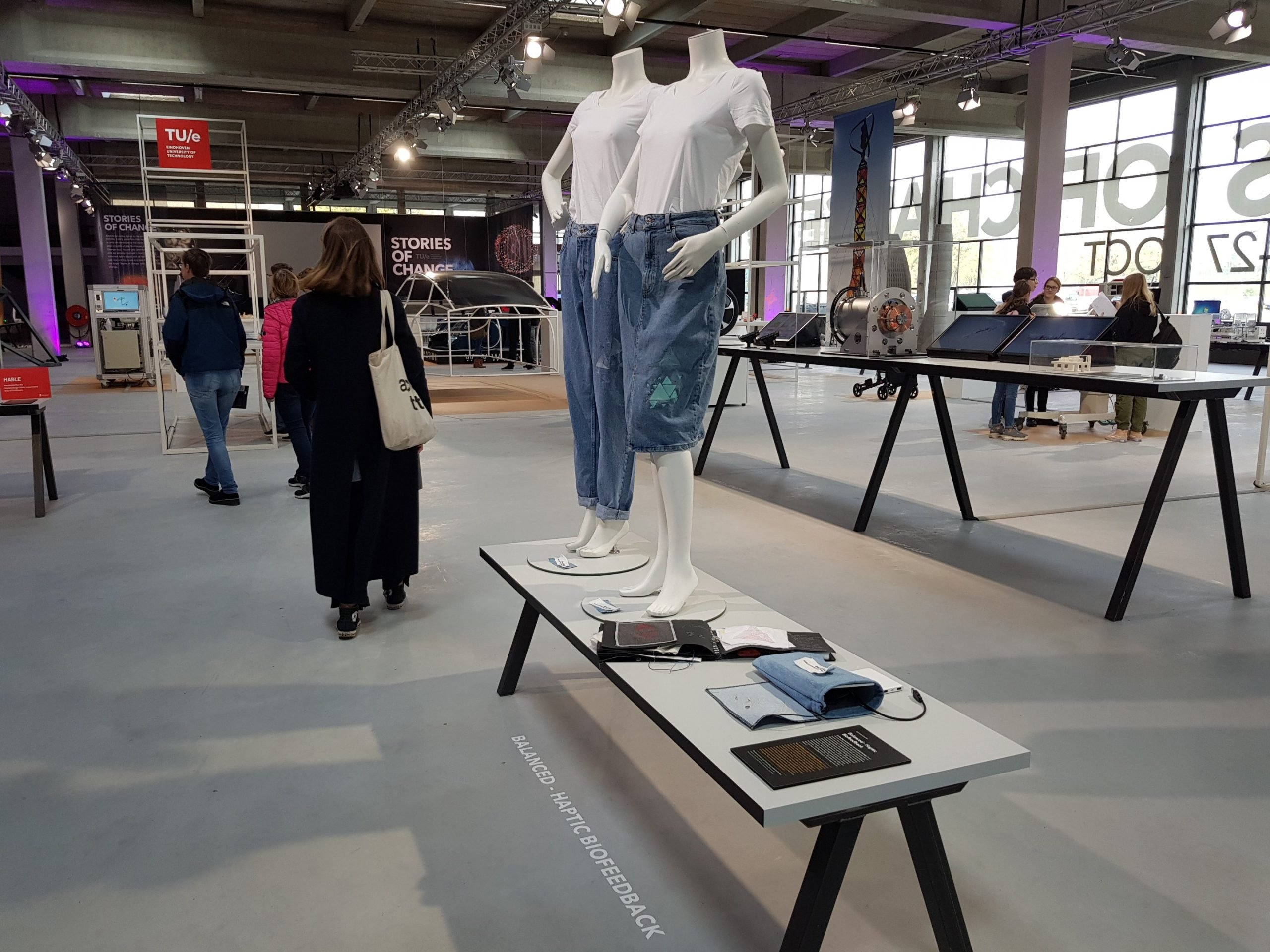
On a busy day, just do a brief breathing exercise to reduce or avoid stress. Industrial Design student at Eindhoven University of Technology (TU/e), Brigitte van der Lugt, has integrated technology into clothing in order to be able to do that. She is presenting her concept at the Drivers of Change exhibition during the Dutch Design Week (DDW).
The technology works on the principle of a magnetic field. Magnets are incorporated into the stitching on a garment. “Stitching is done with two threads. The inside thread is a conductor,” explains Van der Lugt. “An electromagnetic field is created when I let a small amount of current pass through the thread.” AC voltage attracts and repels the magnet. This is how the fabric vibrates. Van der Lugt: “You can do your breathing exercises by using your hands to follow the pattern of the magnets’ vibrations.”
The tempo of the vibrations is linked to the breathing of a specific user. “That way you can slow down your breathing, for instance, and then get back to work.” A user can turn the device on when they want to, or schedule a fixed time for the exercise. In the future, it may even be possible to connect the device to sensors that measure when a user’s breathing is too rapid. “Then the exercise could start when people need it most.”
Subtle technology
The technology was developed by a professor at the university. It was up to Van der Lugt to come up with an application for it. She deliberately chose to use the technology in clothing. It is subtle and personal. “People around the user don’t immediately realize that someone is wearing this technology,” she explains. “I notice that a lot of people say they want to use this kind of help, but that they don’t want other people to be able to notice it straightaway.”

A variety of applications
In Van der Lugt’s view, the presentation of the concept during Drivers of Change is supposed to make people think about the applications for this technology. And that’s working. “Visitors immediately see a variety of possible uses for themselves.” Yoga practitioners, for example, see it as a good support system for their exercises. Athletes also see opportunities. “There are plenty of uses for it,” Van der Lugt says. “I mainly want to show how technology can take various forms and how it can be used in varying ways.” In the coming months, she wants to test the concept on a large scale in order to map out the various experiences. She wants to explore this further and develop it into a product that could enter the market.
Medical technology
There are several projects on healthcare at the Drivers of Change exhibition. From clothing – to an app that reduces stress – to an artificial uterus. For instance, researchers Suzanne Koch and Matilde Putti present a ‘living’ heart valve. The plastic heart valve takes over the function of the damaged heart valve, just like the existing mechanical variant. But the new plastic is also used to activate the body’s own cells. These cells break down the plastic and replace it with healthy cells. This way, the cardiac valve is able to simply grow along with the body and repair itself.

On top of that, installing the new heart valve is also very easy with this technology. “A special device ensures that open-heart surgeries are no longer necessary. The new heart valve is injected into a heart, as it were. This means that it is no longer necessary to stop the heart during surgery,” says Matilde Putti, a PhD student in the field of chemical technology.
One of the spin-offs of this research is the start-up Xeltis. Read more about that company here.
“We want to show people the advantages of this technology during the exhibition”, she continues. “When people receive a new heart valve now, they often have to take medication for the rest of their lives, such as blood thinners. Some people may even have to undergo more surgery if the mechanical heart valve fails to grow with the body.” Koch agrees: “I think it’s great that we can use this technology to ensure that people with heart problems are able to recover fully. Then they don’t have to remain a patient for the rest of their lives.”
These new heart valves are not there for every patient yet. Still, medical technology is making waves – and has been doing so for centuries already. What’s special now, can become normal in a couple of decades. To offer proof of that, one can simply look at what has been achieved around solving a human’s loss of sight. Once a solution for the elite, technology around our eyewear is now available for everyone with a desire to improve eyesight. Even online: Sites like Eyeglasses.com offer the best prescription glasses for anyone’s needs. It may be hard to imagine, but this may once be true for heart valves as well.

Connecting technology and society
During the Dutch Design Week, student teams, spin-offs, PhD students and other TU/e researchers will present their technology at Strijp-T. Vice President of the University, Nicole Ummelen, opened the exhibition with the words: “It is important to make a connection between technology and social problems.” Students present their solutions to a social problem in their own way. From generating energy with iron powder to 3D printed food and from 5G networks to smart drones as assistants.
An impression of “Drivers of Change”

